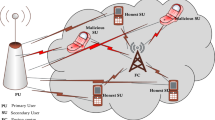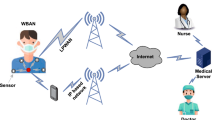Abstract
In radiomobile contexte, radio frequency spectrum is a ressource that needs to be used with appropriate efficiency. This can be achieved by the mean of spectrum sensing operation. This function consists to analyze the occupancy of the radio frequency spectrum in order to detect which bands are unused. This concept is largely appreciated in cognitive radio where more flexibility is required to adapt to the communication environment. Different techniques are presented in the literature. In this paper, we are interested by the application of the energy detector method for spectrum sensing. This application is performed in cognitive radio systems with the use of random sampling. The performance of this approach is evaluated in term of its receiver operating characteristic curve and compared to the uniform sampling case.






Similar content being viewed by others
References
Mitola-III, Jr, J. (2000). Cognitive radio: An integrated agent architecture for software defined radio. Ph.D. dissertation, Royal Institute of Technology, Sweden.
Yucek, T., & Arsalan, H. (2009). A survey of spectrum sensing algorithms for cognitive radio applications. Communications Surveys and Tutorials, 11, 116–130.
Urkowitz, H. (1967). Energy detection of unknown deterministic signals. Proceeding of IEEE, 55(4), 523–531.
Cabric, D., Tkachenko, A., & Brodersen, R. W. (2006). Experimental study of spectrum sensing based on energy detection and network cooperation. In ACM 1st international workshop on technology and policy for accessing spectrum (TAPAS).
Cabric, D., Mishra, S. M., & Brodersen, R. W. (2004). Implementation Issues in Spectrum Sensing for Cognitive Radios. In Asilomar conference on signal, systems and computers.
Wojtiuk, J. J., & Martin, R. J. (2001). Random sampling enables flexible design for multiband carrier signals. IEEE Transactions on Signal Processing, 49(10), 2438–2440.
Bilinskis, I., & Mikelsons, A. (1992). Randomized Signal Processing. Cambridge: Prentice Hall.
Wojtiuk, J. J. (2000). Randomized sampling for radio design. Ph.D. Thesis, University of South Australia, School of Electrical and Information Engineering, Australia.
Shapiro, H. S., & Silverman, R. A. (1960). Alias-free sampling of random noise. SIAM Jouanal of Applied Mathematics, 8, 225–236.
Beutler, F. J. (1966). Error-free recovery of signals from irregularly spaced samples. SIAM Review, 8, 328–335.
Digham, F. F., Alouini, M.-S., & Simon, M. K. (2007). On the energy detection of unknown signals over fading channels. IEEE Transactions on Communications, 55(1), 21–24.
Author information
Authors and Affiliations
Corresponding author
Rights and permissions
About this article
Cite this article
Semlali, H., Boumaaz, N., Soulmani, A. et al. Energy Detection Approach for Spectrum Sensing in Cognitive Radio Systems with the Use of Random Sampling. Wireless Pers Commun 79, 1053–1061 (2014). https://doi.org/10.1007/s11277-014-1917-6
Published:
Issue Date:
DOI: https://doi.org/10.1007/s11277-014-1917-6




